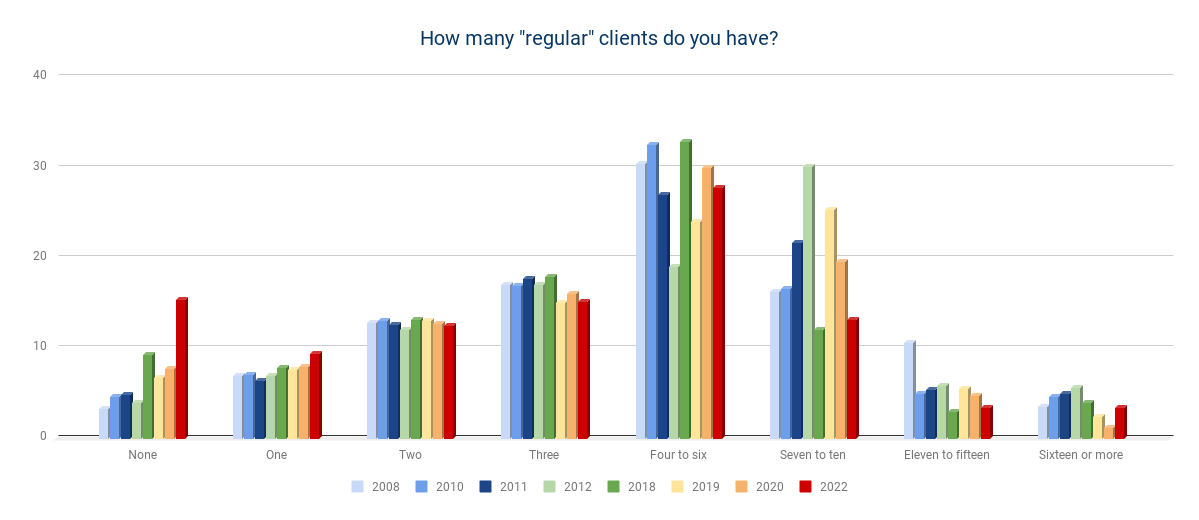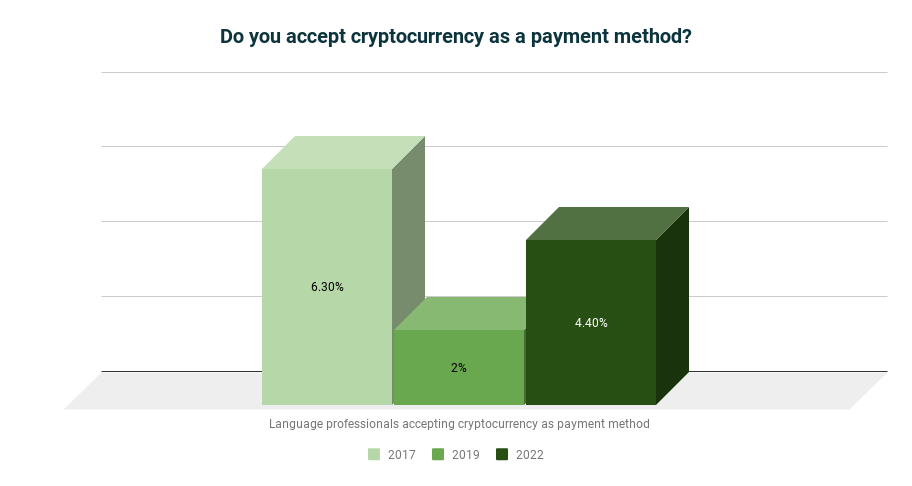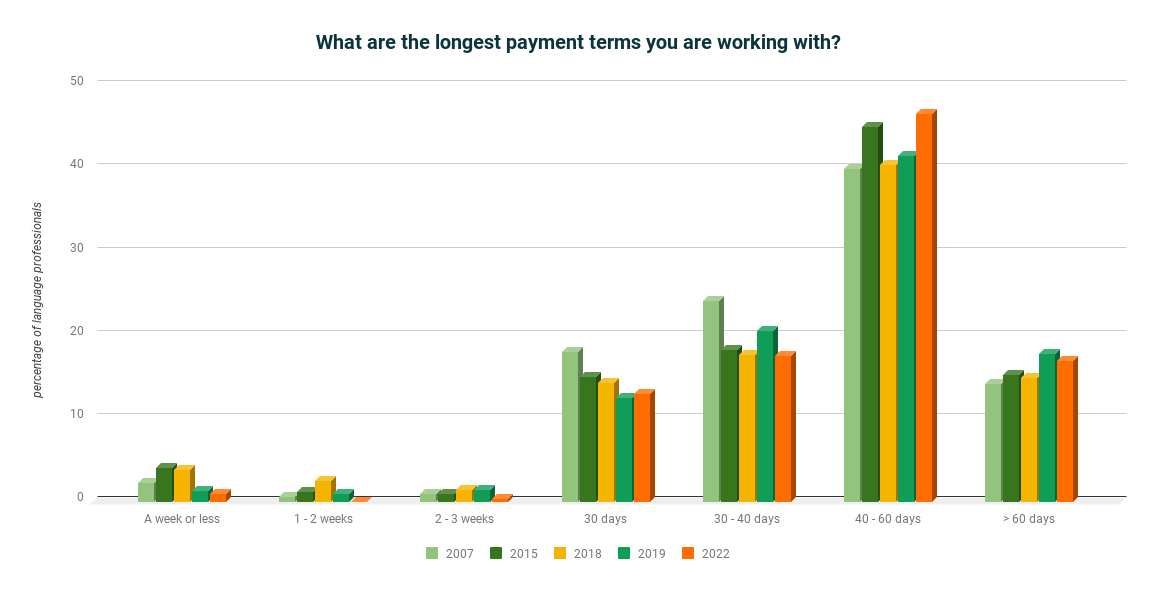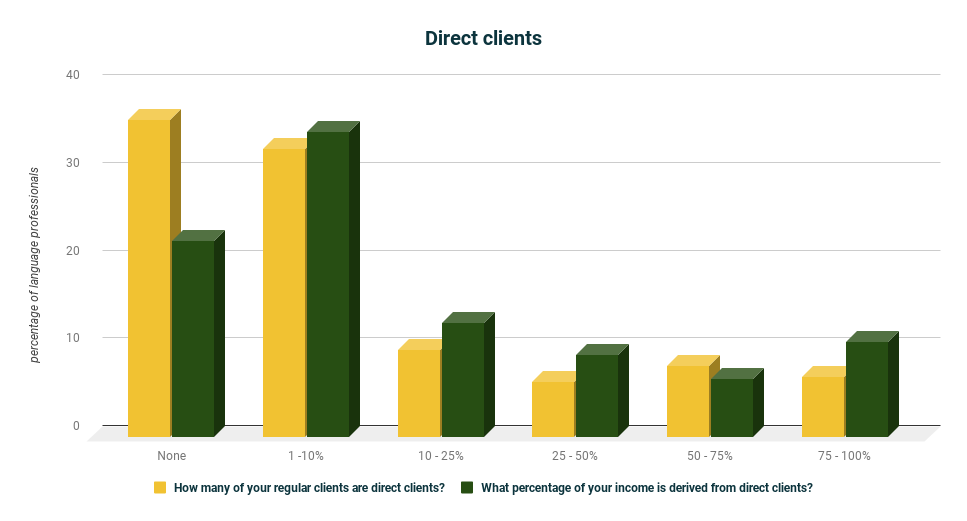Payment methods
Depending on where you are and who you are working for, how you get paid can be an issue. Over 50% of freelance language professionals have at least occasional difficulty matching the payment methods through which they can receive payments with the methods a client uses to make them. For around at least 10%, these issues can seriously affect who they are able to work for.
"What are you even talking about?" asks the EU-based translator working for EU-based clients.
Well, for some language professionals in some countries, payment methods such as PayPal, for example, are either not an option, or the workaround to actually receive the payment involved requires just as much time and energy as the job did. There are more payment handlers than before, and newer options such as cryptocurrency, but nothing has come along which can effectively resolve all issues across the board yet. So for many, the payment method issue can have additional steps which take away from how much they can work, and how much they can enjoy the work they do:
- Find a way to receive payment which is among the client's methods of payment, and then
- Find a way to move that payment to one's bank or to another payment handler which will allow them to easily access or use the funds. And also,
- Find a way to minimize funds lost to handler or transaction fees, or currency conversion, along the way.
Roughly 30% of freelance language professionals have incorporated new payment methods over the last two years in order to increase their "payability" to clients.
A newer payment method, cryptocurrency, has seen a very limited, cautious adoption among language professionals. Cryptocurrency can amplify one's means of receiving payment, but in many cases the issues described above remain-- what do I do with it once I've received it, or how do I get my hands on the actual cash and do my grocery shopping with it? In general, the attitude so far towards cryptocurrency is that it may be a means of investment, or a means of payment for other things, but not so much a means of getting paid oneself. And for the most part, it appears that clients are not clamoring for its use, either. In 2022, almost 25% of language professionals say they would consider offering cryptocurrency as an additional payment method, if it were requested by their clients.
Payment terms
Most language professionals (61%) would rate their own clients' payment terms and practices as good (47%) to excellent (14%), but that also means that 39% rate their clients' payment terms and practices between average and very poor, so there is room for improvement on this front.
A greater percentage are reporting dealing with payment terms in the 40 to 60 day range (nearly 47%), while smaller and smaller percentages are enjoying nearly immediate payment (upon delivery up to three weeks). There was a small uptick in those working with payments in the 30 day range, after several years of gradual decline in that payment term range.
Does client size matter?
Maybe! Around 46% of those who work with translation companies prefer to work with middle to smaller-sized companies. One reason for this preference is that smaller-sized companies are better able to extend certain personal touches which their providers appreciate; the larger the company, the more likely they are to start automating some processes, and these personal touches tend to disappear. Nearly as many, however, have no set preference, as long as the work is interesting and the pay is good.
Workflow and tools
Translation management systems (TMS) continue to be introduced, and existing systems continue to improve. Consensus is that a good TMS can improve the productivity and quality of the output of the company using it. How do translators feel about them, though?
It can be anywhere from an enjoyable, worthwhile experience to outright messy, depending on three main factors:
- Quality/completeness of the TMS
- Number of clients the language professional is serving (the greater the number, the more systems on which they are expected to work or deliver work, in general)
- Frequency of work
For translators who are serving several clients or more, and where each client uses their own or a different translation management system, it can be complicated to become proficient in each platform's use. To a lesser degree, remote interpreters may find themselves in a similar situation if they are serving more than one platform. Username and password management is just the start. The more intricate the system, the more time one may be forced to spend each time around, finding where or how to perform the necessary actions from start to end of the job, to submitting an invoice for payment. This inefficiency increases as the frequency of work provided through the given TMS decreases. One noted benefit on the translator's end is the ease in management of large files. But, in 2022, when it is difficult to not end up on a TMS somehow, and one would think we have moved somewhat beyond using email as a main project management tool, most translators (73%) still prefer the use of email for job coordination, and 70% still submit most of their work via email.
Just under 55% of translators say that most or all of their translation agency clients request or require the use of a specific CAT tool when working with them.
Messaging services such as WhatsApp and Telegram have also taken a role in some workflows, with recruiting, onboarding and project management being carried out using these platforms. Since some companies are already using these to interface with their clients, extending their use to managing workflow may seem natural. However, they also introduce a certain level of risk at the outset of a service provider - client relationship, along with widening the fan of communication methods the provider should stay on top of, and in some cases further blurring the line between professional and personal life and work hours. Recent scams targeting translators have used a WhatsApp or Telegram contact method to "screen" translators and assign work, impersonating a project manager or other employee of a translation company, for example (the "traditional" version of this scam used masked emails or free email addresses which look similar to the company's domain-based email addresses in order to pass themselves off as representatives of the company).
Risk management
The digital age has made so many things easier and faster, but it has been somewhat slower to address an issue that is a product of life on the internet itself: knowing who is really who, and what, they say they are. The days when online anonymity in professional circles was relatively common are over, or soon to end, but it can still be a somewhat nerve-wracking affair to make the right professional connections and to do business online, for freelancers and for their clients alike.
23% of language professionals have been targeted in the last year by scams which are specific to the language industry. These are usually translation-specific, so the victims for the most part have been translators. However, interpreters still need to watch out for the traditional
overpayment scam, both with regards to payment for "jobs" as well as upfront payment for equipment for "jobs."
About half of language professionals will tell you they have improved the way they screen new potential clients over the past couple of years, though around 60% also admit that they could be a bit more rigorous in their risk management. The majority (79%) spend anywhere between 20 minutes and an hour checking relevant details and reputation of a potential client before deciding to move forward.
Direct clients
The needle has not moved much on the translator-to-direct client gauge in the past few years. Many translators continue to seek work with direct clients over work with agencies when they can. For many clients however, it continues to be more efficient to hire a company to tackle their language needs, especially if the work involves more than one language, or services beyond straight translation, since few are able to source and manage these projects on their own, and single translators rarely offer this as part of their services. For "smaller" or single language needs, striking up a relationship with an individual translator can be fruitful: you're talking directly to the person doing the work, and they are more easily able to get to know you, what you do, and your needs as a client, which can pay off big in the long term if you work with them more than just once.
71% of freelance language professionals report that they are working with at least one or two direct clients. For nearly 40%, a significant portion of their income (greater than 10%) comes from their work with direct clients, and around 10% work exclusively or almost exclusively with direct clients.
Room for improvement
Now, most freelance language professionals report that they are in general happy with their clients. But, if you are a buyer of language services, know that at the same time, 59% of them are also on the lookout for "better" clients. Just over 30% have an eye out for higher-paying clients to replace some of their current clients.
There is always room for improvement, right? This applies to a service provider's client roster, and also to a client's processes when dealing with their service providers. Here are a few things which can help make you a better client to current and potential service providers.
- Payment terms and punctuality in payment. It is frustrating and trust-breaking to have to chase payments, or to deal with a payments department where invoices get lost or fall through the cracks. Shorter payment terms also mean happier service providers. Payment systems where the service provider also has access to optional advances before the payment term is up are also appreciated.
- Improved communications and modes of communication. Adding a personalized, human touch to communications can go a long way. When using automated or semi-automated communication, take the steps to customize it appropriately. Avoid the poor impression caused when a service provider who has worked with you before is sent an email for an upcoming job where it seems you have "forgotten" who they are or what they have done for you already.
- Strike the right balance between AI/automation and humans. As you automate the way you source and manage your projects, one aspect to keep in mind should be ease of use for your service providers. How easy is it for them to log in to your system and do what you need them do to? Simple, intuitive interfaces for getting assigned projects, doing work, submitting work, and getting paid can make a difference. How important is it that the work be done on a specific system or tool? If the issue is compatibility, it is possible that you can greatly widen the pool of providers that can work with you by focusing on compatibility rather than on the tool to produce those files, for example.
- Strike the right balance between MT and humans. If you are offering MTPE as an option to your clients, do it right. Service providers who have invested the time in becoming proficient in this kind of work (or who you have invested the time in training) are going to be able to do the work better, as with any kind of specialist. Premium human translations can help offset the discounts you might provide on MT-related services; consider passing that premium down the chain to your providers as well.



.png)




